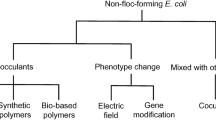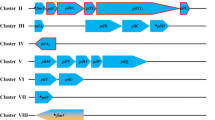Summary
Escherichia coli cells form flocs or aggregates by overproducing type 1 pili. When thepil operon is placed under the control of atac orlac promoter-operator sequence, the bacterial cells can be induced to form flocs by adding isopropyl-β-d-thiogalactopyranoside to the culture medium. This phenomenon of genetically induced flocculation can aid in the downstream processing of biological products. This paper describes the construction of two artificially controlled plasmids which cause cell flocculation. Cell aggregates 50 μm in mean diameter were obtained 1 h after the cells were induced.
Similar content being viewed by others
References
Abraham, S.N., J.D. Goguen and E.H. Beachey. 1988. Hyperadhesive mutant of type 1-fimbriatedEscherichia coli associated with formation of FimH organelles (fimbriosomes). Infect. Immun. 56: 1023–1029.
Chan, W.K., S.-K. Kim, C. Rha and E. Robinson. 1987. Removal of cell and cell debris by electrostatic adsorption of positively charged polymeric particles. In Flocculation in Biotechnology and Separation Systems (Attia, Y.A., Ed.), pp. 429–439, Elsevier Science Publishers, Amsterdam.
Davis, R.H. and T.P. Hunt. 1986. Modeling and measurement of yeast flocculation. Biotec. Prog. 2: 91–97.
de Boer, H.A., L.J. Comstak and M. Vasser. 1983. Thetac promoter: A functional hybrid derived from thetrp andlac promoters. Proc. National. Acad. Sci. 80: 21–27.
Dugan, P.R. 1987. The function of microbial polysaccharides in bioflocculation and bioadsorption of mineral ions. In Flocculation in Biotechnology and Separation Systems (Attia, Y.A., Ed), pp. 337–350, Elsevier Science Publishers, Amsterdam.
Eisenstein, B.I., I. Ofek and E.H. Beachey. 1979. Interference with mannose binding and epithelial cell adherence ofEscherichia coli by sublethal concentrations of streptomycin. J. Clin. Invest. 63: 1219–1228.
Eriksson, L.B. and A.-M. Hardin. 1987. Flocculation ofE. coli bacteria with cationic polyelectrolytes. In Flocculation in Biotechnology and Separation Systems (Attia, Y.A., Ed), pp. 441–455, Elsevier Science Publishers, Amsterdam.
Hanson, M.S. and C.C. Brinton. 1988. Identification and characterization ofE. coli type-1 pilus tip adhesion protein. Nature 332: 265–268.
Hanson, M.S., J. Hempel and C.C. Brinton. 1988. Purification ofEscherichia coli type 1 pilin and minor pilus proteins and partial characterization of the adhesin protein. J. Bact. 170: 3350–3358.
Hudson, L. and F.C. Hay. Practical Immunology. 1985. pp. 238–239, Benjamin/Cummings Publishing Company, Inc., California.
Hull, R.A., R.E. Gill, P. Hsu, B.H. Minshew and S. Falkow. 1981. Construction and expression of recombinant plasmids encoding Type 1 ord-mannose-resistant pili from a urinary tract infection of anEscherichia coli isolate. Infect. Immun. 33: 933–937.
Klemm, P. and G. Christiansen. 1987. Threefim genes required for the regulation of length and mediation of adhesion ofEscherichia coli type 1 fimbriae. Mol. Gen. Gent. 208: 439–445.
Klemm, P., B.J. Jorgensen, I. van Die, H. de Ree and H. Bergmans. 1985. Thefim genes responsible for synthesis of Type 1 fimbriae inEscherichia coli, cloning and genetic organization. Mol. Gen. Genet. 199: 410–414.
Krogfelt, K.A., H. Bergmans and P. Klemm. 1990. Direct evidence that the FimH protein is the mannose-specific adhesin ofEscherichia coli type 1 fimbriae. Infect. Immun. 58: 1995–1998.
Kushner, S.R. 1978. An improved method for transformation ofEscherichia coli with Col E1 derived plasmids. In Genetic Engineering (Boyer, H.W. and A. Nicosia, Eds.), pp. 17–23, Elsevier/North Holland Biomedical Press, Amsterdam.
Maurer, L. and P.E. Orndorff. 1987. Identification and characterization of genes determining receptor binding and pilus length ofEscherichia coli type 1 pili. J. Bact. 169: 640–645.
McMichael, J.C. and J.T. Ou. 1979. Structure of common pili forEscherichia coli. J. Bact. 138: 969–974.
Minion, F.C., S.N. Abraham, E.H. Beachey and J.D. Goguen. 1986. The genetic determinant of adhesive function in type 1 fimbriae ofEscherichia coli is distinct from the gene encoding the fimbrial subunit. J. Bact. 165: 1033–1036.
Neeser, J.-R., B. Koellreutter and P. Wuersch. 1986. Oligomannoside-type glycopeptides inhibiting adhesion ofEscherichia coli strains mediated by Type 1 pili: preparation potent inhibitors from plant glycoproteins. Infect. Immun. 52: 428–436.
Orndorff, P.E. and S. Falkow. 1984. Organization and expression of genes responsible for Type 1 piliation inEscherichia coli. J. Bact. 159: 736–744.
Orndorff, P.E. and S. Falkow. 1984. Identification and characterization of a gene product that regulates Type 1 piliation inEscherichia coli. J. Bact. 160: 61–66.
Sambrook, J., E.F. Fritsch and T. Maniatis T. 1989. Molecular Cloning. A Laboratory Manual, 2nd. edition, Cold Spring Harbor Laboratory Press, NY.
Tadikonda, K. 1990. Affinity Cell Separations. Masters' Thesis, University of Colorado.
Warne, S.R. and C.P. Bowden. 1987. Biosurface properties and their significance to primary separation: a genetic approach to the utilization of bacterial auto-aggregation. In Separations for Biotechnology (Verrall, M.S., and M.J. Hudson, Eds.), pp. 1–15, Ellis Horwood Ltd., Chichester, U.K.
Author information
Authors and Affiliations
Rights and permissions
About this article
Cite this article
Ogden, K.L., Taylor, A.L. Genetic control of flocculation inEscherichia coli . Journal of Industrial Microbiology 7, 279–286 (1991). https://doi.org/10.1007/BF01577656
Received:
Revised:
Accepted:
Issue Date:
DOI: https://doi.org/10.1007/BF01577656




